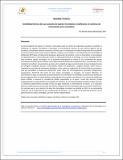| dc.contributor.author | Jiménez Montealegre, Ricardo | |
| dc.date.accessioned | 2020-10-16T22:56:29Z | |
| dc.date.available | 2020-10-16T22:56:29Z | |
| dc.date.issued | 2017-07-01 | |
| dc.identifier.uri | http://hdl.handle.net/11056/18364 | |
| dc.description.abstract | La bioremediación de aguas en sistemas recirculados para el cultivo de organismos acuáticos mediante la utilización de tapetes microbianos construidos es parcialmente efectiva ya que elimina algunos de los productos no deseados (amonio-amoniaco, nitritos), pero no disminuye de manera importante la acumulación de otros productos tales como materia orgánica, nitratos y orto-fosfatos. La incorporación de la tecnología de bioflóculos (BFT) para el tratamiento de aguas y generación de proteína in situ en Acuicultura se ha evaluado con bastante éxito en otras partes del mundo y a nivel experimental; sin embargo, no se han realizado intentos para combinar ambas tecnologías. En la presente investigación se evaluó el uso combinado de tapetes microbianos y bioflóculos en sistemas recirculados (RAS) de producción a pequeña escala. La evaluación se hizo mediante la medición de parámetros químicos de la calidad del agua (concentración de las principales formas de nitrógeno inorgánico disuelto, orto-fosfatos, sólidos en suspensión y oxígeno disuelto, entre otros), y mediante la evaluación de parámetros biológicos, tanto sobre los organismos en cultivo (tasa de crecimiento, tasa de mortalidad y conversión alimenticia) como sobre los microorganismos asociados (fitoplancton, zooplancton). Partiendo del hecho de que ambas tecnologías se encargan, de manera diferente, de biorremediar el agua, se esperaba que éstas pudieran ser combinadas. Sin embargo, la presencia de bioflóculos afectó negativamente el mantenimiento y desempeño de los tapetes microbianos; la presencia de bioflóculos causa turbidez y aumenta la cantidad de sólidos suspendidos en el agua, y estos dos factores inciden negativamente en el desempeño de los tapetes microbianos. En un intento de lograr combinar ambas técnicas, se realizaron experimentos variando el flujo de agua empleado, la intensidad de aireación, y se evaluaron diversas modificaciones estructurales del sistema. Ninguna de estas estrategias logró una mejoría importante. Se concluye que el uso conjunto de estas dos tecnologías no parece ser posible en RAS, no se recomienda continuar con la evaluación de esta combinación de técnicas, y en su lugar se recomienda continuar con la optimización de ambas estrategias, pero de manera independiente. | es_ES |
| dc.description.abstract | Bioremediation of water in recirculated systems for the cultivation of aquatic organisms through the use of constructed microbial mats is partially effective since it removes some of the unwanted products (ammonia-ammonia, nitrites), but does not significantly reduce the accumulation of others. products such as organic matter, nitrates and ortho-phosphates. The incorporation of bioflocicle technology (BFT) for water treatment and in situ protein generation in Aquaculture has been evaluated with considerable success in other parts of the world and at an experimental level; however, no attempts have been made to combine both technologies. In the present investigation, the combined use of microbial mats and biofloccules in recirculated systems (RAS) of small-scale production was evaluated. The evaluation was made by measuring chemical parameters of water quality (concentration of the main forms of dissolved inorganic nitrogen, ortho-phosphates, suspended solids and dissolved oxygen, among others), and by evaluating biological parameters, both on organisms in culture (growth rate, mortality rate and feed conversion) as well as on associated microorganisms (phytoplankton, zooplankton). Starting from the fact that both technologies are responsible, in a different way, for bioremedying water, it was hoped that they could be combined. However, the presence of bioflocules negatively affected the maintenance and performance of the microbial mats; the presence of bioflocules causes turbidity and increases the amount of suspended solids in the water, and these two factors negatively affect the performance of microbial mats. In an attempt to combine both techniques, experiments were carried out varying the flow of water used, the intensity of aeration, and various structural modifications of the system were evaluated. Neither of these strategies achieved a significant improvement. It is concluded that the joint use of these two technologies does not seem to be possible in RAS, it is not recommended to continue with the evaluation of this combination of techniques, and instead it is recommended to continue with the optimization of both strategies, but independently. | es_ES |
| dc.description.sponsorship | Universidad Nacional, Costa Rica | es_ES |
| dc.language.iso | spa | es_ES |
| dc.rights | Acceso abierto | es_ES |
| dc.subject | ACUICULTURA | es_ES |
| dc.subject | BIOFLÓCULOS | es_ES |
| dc.subject | TAPETES MICROBIANOS | es_ES |
| dc.subject | SISTEMA RECIRCULADO | es_ES |
| dc.subject | RAS | es_ES |
| dc.title | Factibilidad técnica del uso conjunto de tapetes microbianos y bioflóculos en sistemas de recirculación para acuicultura | es_ES |
| dc.type | http://purl.org/coar/resource_type/c_93fc | es_ES |
| dc.description.procedence | Escuela de Ciencias Biológicas | es_ES |

